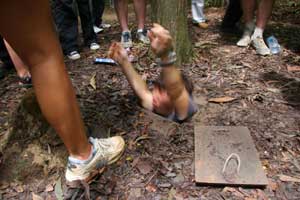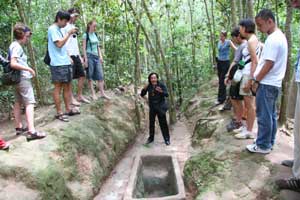 By KEVIN SITES Yahoo! News September 02, 2006
They hoped to counter the strength and influence of the Viet Cong or VC (Vietnamese communists allied with the north) in the region, who were in easy striking distance of Saigon only 37 miles away.
But it wasn't until many weeks later that the Army realized it had built the camp on top of part of the Viet Cong's underground tunnel network - allowing VC to pop up from camouflaged hatches inside the American perimeter and attack the Americans while they slept. It was if they had set up their tents on the mounds of stinging ants. Having difficulty finding and fighting the VC in their elaborate tunnel network that spider-webbed through the countryside for 124 miles, the United States began using chemicals like the infamous herbicide, Agent Orange, to defoliate the area. When that failed, they began sending soldiers called "tunnel rats" into the underground network to find and destroy the VC, but more often than not, it was the tunnel rats who ended up dead. Toward the end of the 1960s the United States carpet-bombed the region with B-52s, destroying almost everything in the district - including most of the tunnels. By that time it was too late. The tunnels had already done their job, including helping facilitate the 1968 Tet Offensive, which many historians believe turned the tide of the war. The legacy of the tunnels has not just been relegated to the history books. Intelligence analysts familiar with the military tactics of Hezbollah say the guerrilla group studied the VC tunnel network in creating their own bunker system in south Lebanon and used it successfully against the Israel Defense Forces during the recent conflict. Today, the tunnels of Cu Chi have become one of the most popular tourist destinations near Ho Chi Minh City, formerly Saigon. Guides escort more than 400 visitors through the grounds each day, beginning with a viewing of an old black and white propaganda film extolling the exploits of the VC fighters who used the tunnels. In a classroom setting, the guides explain the history of the tunnels and how they were built over 25 years, beginning in the late 1940s by the Viet Minh, the rebel army fighting French colonialism in Vietnam. A tour guide nicknamed Jackie (because he looks like Jackie Chan, he says) pulls up the lid of one of the well-concealed wooden hatches to a small hideaway. It fits perfectly flush with a square-framed box, sealing out rain water. Surprisingly, when Jackie kicks dirt and leaves over the top, it disappears. "When the U.S. soldier opens," he says, "it is very narrow, he cannot enter." Jackie invites people on the tour to try and fit down the hole. One man from Ireland removes everything in his pockets but still can't get his hips through the opening. Next Jackie shows the group a series of primitive but effective booby traps designed to stop the tunnel rats and search dogs that the U.S. Army set down into the systems. Finally, we get a chance to experience what it was like to move through the tunnel system itself. Jackie shows us into an entrance enlarged for tourists. Those who want can enter the tunnels and emerge 15 minutes and a few hundred feet away. These tunnels at Cu Chi are not for the claustrophobic. The passageways are hot, dark and tiny, a little more than 3 feet high and 2 feet across. With all my camera gear, I can only negotiate it crawling on my hands and knees. There are a few dim lights along the way, which illuminate only a few feet of the tunnels. Once you pass them you are moving in almost total darkness. Emerging near the end, dirty and drenched in sweat from the crawl, I wonder how anyone could have spent months in the tunnels when even a few minutes seems a difficult ordeal. Still, the tunnels are a significant historical landmark, as well as a big tourist draw for Vietnam today. And despite their strategic value to the North Vietnamese war effort, they also signify the sacrifice of those committed to that cause. Of the 16,000 VC that lived in and fought from the tunnels, only 6,000 survived the war.
Distributed to subscribers for publication by Scripps Howard News Service, http://www.shns.com Publish A Letter on SitNews Read Letters/Opinions
|
||

